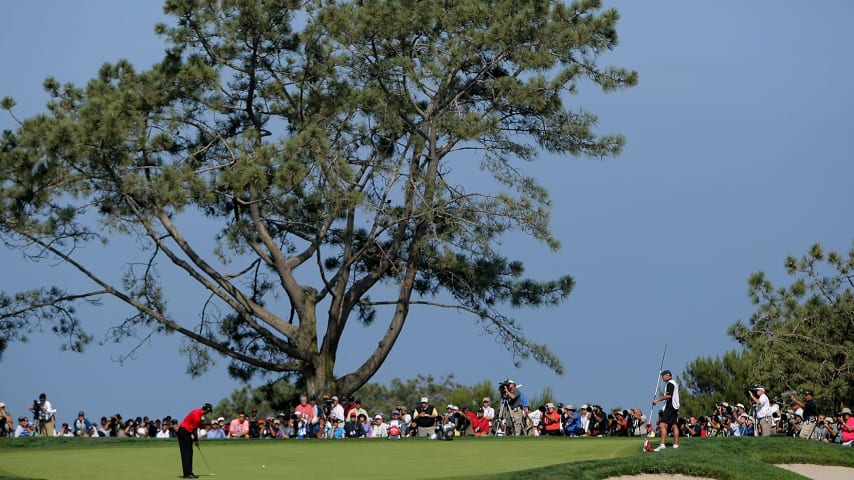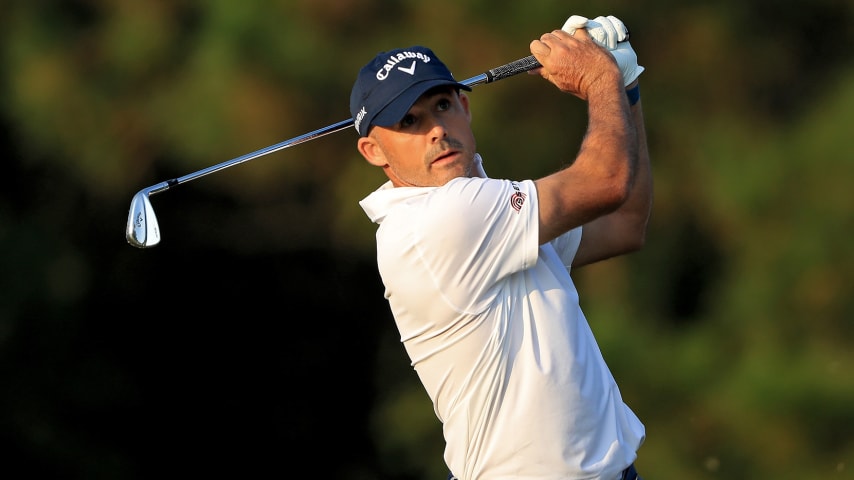Nine things about Torrey Pines South
6 Min Read

It’s a slightly different course from the one that hosted the 2008 U.S. Open
Written by Cameron Morfit
It’s a slightly different course from the one that hosted the 2008 U.S. Open
A lot of things have changed 13 years later – the most jarring being Woods’ absence due to injuries sustained in a single-car accident in February. Xander Schauffele, one of the pre-tournament favorites this week, was a teenage fan watching from a tree in ’08.
The golf course, which Rees Jones renovated again in 2019, is also different. It has hosted the San Diego City Amateur, the Junior World, the Farmers Insurance Open, and now, for the second time, it will be the setting for the U.S. Open – playing at 7,652 yards as a par 71, with a few subtle changes.
Here are nine things about Torrey Pines South.
1. It is named for a tree – and a man
The Torrey pine – which is featured in the trophy for the Farmers Insurance Open, the annual PGA TOUR stop – is native only to the 36-hole golf complex, Torrey Pines State Reserve next door, and Santa Rosa Island (near Santa Barbara).
The tree features clusters of five pine needles, and because it is protected, when some 30 Torrey pines were removed from the South Course they were simply relocated and transplanted.
Although early Spanish explorers certainly knew of the tree, Dr. Charles Christopher Parry, a botanist for the U.S.-Mexico Boundary Survey, officially discovered it. He named it for his mentor, Dr. John Torrey, who had co-written “A Flora of North America” and was the solo author of “A Flora of New York State.” Torrey never visited the region, but Parry sent him samples of the tree.
2. It was a military training camp
Camp Callan opened on what is now Torrey Pines Golf Course in 1941, just prior to the Pearl Harbor invasion. It was used for anti-aircraft artillery replenishment, and roughly 15,000 people lived on site. There were movie theaters and chapels, among other conveniences.
After WWII, the government sold the land and buildings back to the city of San Diego. Lumber from the buildings would be used to build housing for veterans.
3. It was a racecourse
The term “driver” once meant something completely different at Torrey.
After Camp Callan, the land was repurposed to build a grand prix racecourse, hosting car-racing contests that included some of the biggest names in driving. Among them were Carroll Shelby, who was played by Matt Damon in the movie “Ford vs. Ferrari.” The last race was held in 1956.
4. A father-son team built the golf courses
William P. Bell, who was born in 1886 and apprenticed under Willie Watson and George Thomas, Jr., was a turf consultant for the U.S. Army Corps of Engineers during WWII, and shortly after that was joined by son William F. Bell in the family golf course design business.
A special city election in ’56 led to the dedication of roughly 100 acres of the former Camp Callan being set aside for the creation of a golf course. William P. had the original vision for Torrey Pines, but he had died by the time Torrey Pines was built. His son, William F., oversaw its creation in the late 50s.
The City of San Diego Parks & Recreation has called them “California’s First Family of Golf Course Design,” noting their work on Torrey Pines, but also the father’s contributions to Bel-Air, Riviera and Los Angeles country clubs, and the son’s involvement in Sandpiper and Industry Hills golf clubs, and Bermuda Dunes Country Club.
5. It has had many redesigns
Rees Jones (2001, 2019) isn’t the only one to have a hand in transforming Torrey South.
Billy Casper, perhaps the most famous golfer in San Diego history, and architect David Rainville oversaw the first redesign in the mid-1970s. Stephen Halsey and Jack Daray, Jr., redid it in ’88.
In the spring of ’99 the City of San Diego Parks and Recreation began a five-year capital improvement program for the courses. Jones moved four green structures and added 10 new tees to stretch the course from 7,000 to nearly 7,600 yards.
The most difficult hole in ’08 was the narrow, 501-yard, par-4 12th, which often plays into the wind coming in off the Pacific Ocean. Two new bunkers were added in the ’19 Jones redesign, but that’s not all he changed.
A new tee and two new bunkers down the left side have added a new wrinkle to the 612-yard, par-5 13th hole. A new tee has added 37 yards to the par-4 15th hole, as has a new low chipping area front-left of the green, which will collect errant shots.
A new tee has been added to the left of the previous tee on 17, creating a new angle that favors a draw into the fairway. The hole features the shallowest par-4 green, 26 yards.
6. There will be similarities to ’08
The fairways and rough are still mostly kikuyu, the greens poa annua. Devlin’s Billabong, the large bowl of soup fronting the 18th green, is still the only water hazard (other than the Pacific Ocean). The 387-yard second hole is still the only par 4 under 400 yards.
Additionally, the picturesque, 195-yard third hole, which plays downhill into the prevailing wind, is still the signature par 3. With multiple teeing areas and wind directions, it can call for anything from a pitching wedge to a long iron.
As in ’08, the dogleg-right sixth hole, which plays as a 560-yard par 5 during the Farmers Insurance Open, will be converted to a 515-yard par 4.
The easiest hole in ’08 was the 568-yard, par-5 18th (4.79 average), the site of the do-or-die Woods’ putt, and Dan Hicks’ call: “Expect anything different?” Expect it to be the easiest this time around, as well.
7. Torrey Pines Lodge has transformed, too
The sprawling hotel nestled up against the 18th hole has also changed appearances.
It was originally built as a 74-room inn in 1961. It was closed in 2000 for a total remodel, and reopened in ’02 as a 170-room luxury hotel in early California craftsman style, with two restaurants and lounges. It has an AAA Five Diamond rating.
8. Tiger isn’t the only big name there
In addition to winning the ’08 U.S. Open, Woods has won the Farmers Insurance Open seven times – including four straight from ’05 to ’08 – at Torrey South.
But Tom Weiskopf is another big name at Torrey. He redesigned the North Course in 2016, and won what would become the Farmers in its first year using Torrey South in 1968. (It used a variety of sites, primarily Stardust Country Club, before that.)
Jack Nicklaus won in ’69, so you could say Torrey South got off to a solid start.
9. Phil Mickelson still has good vibes
Phil Mickelson, who is coming off a stunning victory at the PGA Championship last month and needs only to win the U.S. Open to complete the career Grand Slam, has admitted to struggling at Torrey South since Rees Jones redesigned it in 2001. Paul Azinger speculated on an NBC conference call that he lost his advantage of knowing the greens. Mickelson faulted his too-aggressive style of play, especially on approach shots.
Still, it’s worth remembering that he won what we now know as the Farmers Insurance Open in 1993, 2000 – halting Tiger’s six-tournament winning streak – and 2001.
“I tried to force it,” Mickelson said recently of his struggles since then. “A lot of pins you can't go to, you have to play 60, 50 feet away and a lot of holes I get overly aggressive, obviously that's my nature. There's a proper way to play it, and I've seen it and I want to have the discipline to do it and so I want to spend some time out there to develop a good game plan.”






